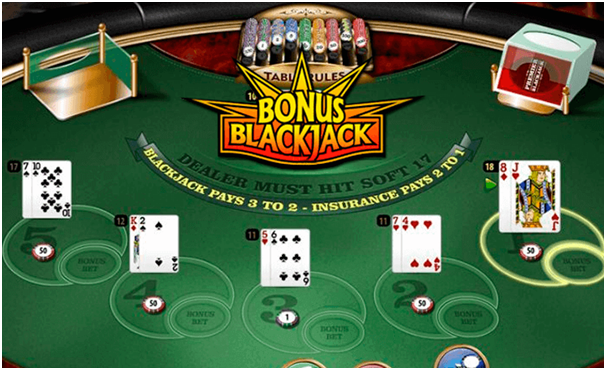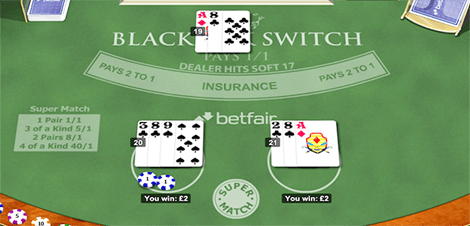Types Of Blackjack Bets
This blackjack side bet, which has been spotted in Las Vegas, Atlantic City, and Tunica, is one of the better side bets in blackjack from the player’s perspective. The expected return ranges from 99.41% for a popular one-deck variation to a 96.15% for one of the six-deck variations. Whether you're prowling the casinos on the Las Vegas Strip or downtown on Freemont Street, Marc Meltzer has scouted the best blackjack options for gamblers of all shapes and sizes. The most common types of blackjack involve the following: Blackjack switch – The player plays two combinations with two cards simultaneously. The player is allowed to swap his second card between his two hands. If the dealer reaches 22, the player gets his bet back. Top 10 Types Of Blackjack Classic Blackjack Progressive Blackjack European Blackjack Atlantic City Blackjack Spanish 21 Blackjack Switch Vegas Strip Blackjack Pontoon Super Fun 21 Online version.
Types Of Blackjack Bets No Deposit
. Progressive Blackjack. This type of blackjack bears almost all features from the classic blackjack. The difference comes in the winnings. With each round, a player has a chance of winning the jackpot. For a player to participate in the next round, the player has to increase the bet by an additional amount. Hence the name, progressive blackjack.
A player seated at a blackjack table suddenly places a large bet and the dealer calls out “cheques play!” The skill level of the player needs to be established. The usual way to do this is to study the player’s bets and play to determine if he is counting cards. If so, appropriate actions may be taken against the player. However, there are many ways to beat blackjack that have nothing to do with card counting. Among these are shuffle tracking, edge sorting, collusion, card marking and hole-card play. None of these players will be detected by the usual approach.
An alternative approach is to classify a player as one of the types of non-advantage players given below and then ask if the reason for the wager is consistent with the classification. Any discrepancy between style and reason merits further investigation of the player as a potential advantage player or cheat.
What follows is a guide to those players who often make sudden large wagers, but are not a threat.
The steaming player
It is the end of a session, or a long day, or an entire vacation and the player is hoping for a miracle win to recoup losses. Typically, steaming players will continue to bet large, once they have begun. Many advantage players attempt to look like steamers, however their large bets almost always come at the end of the deck or shoe. For the actual steamer, these large bets can come at any time, and will continue until the player is completely broke, has a huge and significant win, or is persuaded to leave by a friend or relative. This type of player is not a threat.
A steaming player may …
- Play large bets for only a very short time if these bets are lost.
- Show emotional distress, intoxication, or extreme tiredness.
- Have significant personal belongings nearby.
- Be surrounded by friends/family.
- Play with cash.
- Be weak at basic strategy.
The progression player
A progression is a betting scheme that is based on a numerical sequence (for example, double up on each loss). Many card counters try and mask their wagers to look as though they are following a progression. Unlike a card counter, a progression player should be encouraged to continue. The variety of progression betting patterns that players follow is as rich as it is useless. Here are a few tips to help identify a progression player.
A progression player may …
- Continue to increase (or decrease) the bet in a fixed pattern during a series of wins (or a series of losses).
- Forgo many double downs and splits.
- Spread from the table min to the table max chasing losses.
- Place a large bet in a negative count.
- Increase a bet even after high cards have come out the previous round.
- Be strong in basic strategy in areas other than double downs and splits.

The intuitive/streak player

This player may jump bet sizes through a large spread, but there is no correlation between the wager and the count. Most players claim to have intuition, or sense when a shoe is hot or cold, or believe in streaks. Such players wait until they feel the moment is right to place large bets. This type of player is more common on high-limit shoe games, and may even make these wagers to impress other players or the gallery. Clearly such a player is not a threat. However, such a player is a common model for the covert advantage player operating on a card counting team. Therefore if this model is suspected, it may be appropriate to have surveillance count down the shoe/deck on a large wager to help with the identification.


An intuitive/streak player may …
Types Of Blackjack Bets Odds
- Place consistent wagers – either large or small (corresponding to a cold or hot shoe/dealer).
- Make infrequent large wagers, usually not in succession (corresponding to the player’s intuition).
- Make the large wager after a series of losing hands by the dealer.
- Make the large wager after a series of winning hands, especially if those wins are composed of high cards.
- Discuss topics at the table such as “flow”, “clumping”, “streaks”, and “hot/cold” shoes or dealers.
- Be a strong basic strategy player.
The roaming player
Types Of Poker Bets
This is potentially a very dangerous type of player. This player should be allowed to make one large bet without evaluation. However, if the player continues to roam between tables making single large bets, or plays out the shoes at these large wagers, then immediate action should be taken to identify the player as an advantage player. Effectively the player may be a counter spreading from zero dollars to the table limit. However, many roamers are not advantage players, and the unskilled roamer should be welcomed.

A roaming player may …
- Leave a table after a specific number of consecutive losing hands.
- Spend a lot of time watching games.
- Enter a table after the dealer has lost a specific number of hands.
- Play with large amounts of cash.
- Enter a table at any point of the shoe.
- Never play heads-up against the dealer.
The four types of players discussed above are the most common non-threatening big bettors. Once identified, they should be welcomed. Of course, there are many other types of non-threatening players who may make sudden large bets.
Here are a few examples:
Types Of Blackjack Systems
- The newlywed wagering gift money.
- The drunken college kid on a weekend binge.
- The high-roller waiting for a friend.
- The slot jackpot winner trying a new game.
Types Of Blackjack Bets Against
The lesson here is that there are many reasons players make sudden large wagers in blackjack that have nothing to do with advantage play. It takes discipline, study, and experience to be able to recognize an advantage player, but non-advantage players can be easily distinguished. Even at single deck, a player who fits one of these classifications should be allowed to spread from table minimum to table maximum without concern. By limiting non-advantage players in any way, the casino is limiting its own bottom line.